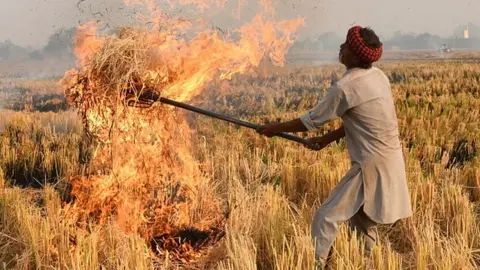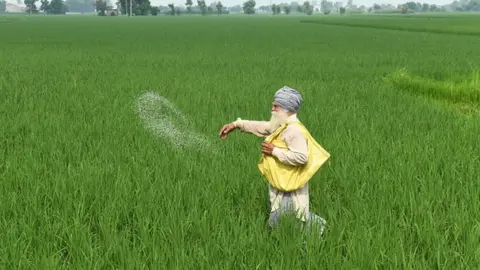Air pollution: Delhi's smog problem is rooted in India's water crisis
 AFP
AFPEvery winter, Indian capital Delhi's toxic air is fuelled by farmers burning crop stubble. But the fires don't stop. Why? The answer lies in water, writes climate expert Mridula Ramesh.
India loses an estimated $95bn (£70bn) to air pollution every year.
From mid-March to mid-October, when Delhi's air quality varies from good to moderate to unhealthy for sensitive groups, chatter on air pollution and its causes is muted.
But then comes winter. Pollution in any city mixes vertically in the atmosphere, and the height at which this happens shrinks by more than half in the winter, raising the concentration of pollution. Two new sources also enter the mix. By the end of October, when the rains have ceased, the winds begin to blow in from the northwest, carrying fumes from burning fields. Then there is the Diwali, the popular festival lights, where millions burst fire crackers to celebrate.
Both of these play a large role in the spike in pollution. In the first week of November 2021, when Delhi's air quality went beyond hazardous, stubble burning accounted for 42% of the city's PM2.5 levels - these are tiny particles that can enter the lungs.
Governments have banned the practice, imposed fines and even suggested alternate uses for the straw and other crop residue. But farmers continue to burn stubble. Why?
Think of the fields that are on fire. They get only between 500-700mm (19-27 in) of rainfall a year. Yet, many of these fields grow a dual crop of paddy and wheat. Paddy alone needs about 1,240mm (48.8 in) of rainfall each year, and so, farmers use groundwater to bridge the gap.
The northern states of Punjab and Haryana, which grow large amounts of paddy, together take out roughly 48 billion cubic metres (bcm) of groundwater a year, which is not much less than India's overall annual municipal water requirement: 56bcm. As a result, groundwater levels in these states are dropping rapidly. Punjab is expected to run out of groundwater in 20-25 years from 2019, according to an official estimate.
The burning fields is a symptom of the deteriorating relationship between India and its water.
Long ago, farmers grew crops based on locally available water. Tanks, inundation canals and forests helped smoothen the inherent variability of India's tempestuous water.
But in the late 19th Century, the land began to transform as the British wanted to secure India's north-western frontier against possible Russian incursion. They built canals connecting the rivers of Punjab, bringing water to a dry land. They cut down forests, feeding the wood to railways that could cart produce from the freshly watered fields. And they imposed a fixed tax payable in cash that made farmers eager to grow crops that could be sold easily. These changes made farmers believe that water could be shaped, irrespective of local sources - a crucial change in thinking that is biting us today.
 Getty Images
Getty ImagesAfter independence from the British in 1947, repeated droughts made the Indian government succumb to the lure of the "green revolution".
Until then, rice, a water-hungry crop, was a marginal crop in Punjab. It was grown on less than 7% of the fields. But beginning in the early 1960s, paddy cultivation was encouraged by showing farmers how to cheaply and conveniently tap into a new, seemingly-endless source of water that lay underground.
The flat power tariffs to run borewells were cheapened and finally not paid - removing any incentive to conserve water. Water did not need to be managed, farmers were taught, only extracted. In the heady first years of the revolution, fields began to churn out paddy and wheat, and India became food-secure. But after a couple of decades, the water began to sputter.
To conserve groundwater, a 2009 law forbade farmers from sowing and transplanting paddy before a pre-determined date based on the onset of the monsoon. The aim was to make the borewells run less in the peak summer months.
But the delay in paddy planting shrunk the gap between the paddy harvest and sowing of wheat. And the quickest way to clear the fields was to burn them, giving rise to the smoky plumes that add to northern India's air pollution.
So, the toxic smog is but a visible symbol of India's trainwreck of a relationship with its water.
 Getty Images
Getty ImagesTo tackle this problem, Indians need to respect their water again - a tall ask after decades of neglect.
Take people's choices in food and crops. A century ago, most Indians ate the hardy millet, which could withstand the vicissitudes of India's water. Today, there are far more Indians, and they eat rice and wheat rotis (flatbreads), making millets an unappealing crop for farmers to grow.
And pricing water, directly or through electricity that powers the borewells, is seen as political suicide. Meanwhile, as air quality improves from hazardous to (very) unhealthy, people, courts and political leaders have moved on - at least until next November.
But the time bomb - of depleting groundwater - ticks on. Once that runs out, the November air might be cleaner.
But what will India do about food?
Mridula Ramesh is a leading climate and water expert and author of Watershed: How We Destroyed India's Water and How We Can Save It and The Climate Solution: India's Climate-Change Crisis and What We Can Do about It.
Follow her on Twitter @mimiramesh
